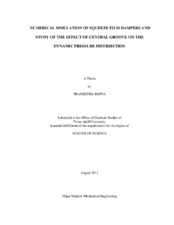| dc.description.abstract | Squeeze film dampers are used in the high speed turbo machinery industry and aerospace industries as a means to reduce vibration amplitude, to provide damping, to improve dynamic stability of the rotor bearing system and to isolate structural components. The effects of cavitation included in previous studies were not effective. The effect of different design parameters were not studied thoroughly as experimental investigation of squeeze film dampers is very expensive. Few of them used numerical investigation but the methods they used are either time consuming or complicated. The present study investigated the feasibility of applying a steady state solver, which is computationally less expensive, for analyzing flow field inside the squeeze film dampers. The behavior of dynamic pressure profiles at different operating conditions, and the effect of a central groove on dynamic pressure profiles were also studied.
Simulation results of a 3D case which is similar to the one experimentally studied by Delgado were used to establish if the moving reference frame (MRF) model in Fluent 12.1 can be used. A steady state solver in an absolute frame of reference was used to produce whirling motion of the rotor in this study. The inlet pressure of 31kpa and the whirling speed of 50 and 100Hz were used as boundary conditions. The mixture model with three percent dissolved air in lubricant is used to model multiphase flow. Singhal cavitation model is used to model cavitation. The simulations (50,000 iterations) were run until steady state solutions were reached. The results closely agreed with those obtained experimentally by San Andrés and Delgado. Numerical simulations of three-dimensional cases with an additional central groove on the squeeze film land were also performed to predict the effect of central groove on dynamic pressure profiles. Addition central groove reduces the pressures and forces generated by squeeze film damper. | en |


